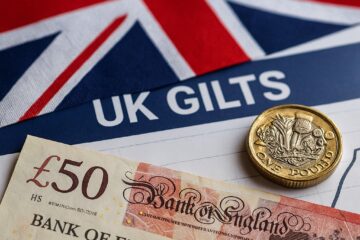In our Special Report (https://bsic.it/2013/10/19/bsic-special-report-twitter-ipo/), we analyzed Twitter’s characteristics, comparables and ratios. We valued Twitter shares at approximately 25$, really close to the final offering price (26$). After the IPO, Twitter’s share price dramatically soared to 45$, an unbelievable 72% surge:
Analysts seem to agree with our view, and Mr. James Mackintosh, investment editor at the Financial Times, on November 8th, reported: “Twitter’s price can only be justified by very bullish assumptions about growth, profitability and its share of online advertising”. Not to mention that the market seems to be in a risk on phase, given the increasing investments in high yield (junk) bonds and the declining VIX index:
Therefore, two different strategies, differentiated on the basis of their holding period, are presented:
Short Term – Short Strangle
What we are suggesting is that Twitter share price will see no big changes in the short term. It may still be sticky around 40-45$ in the very short-term and eventually move for a variety of reasons, such as poor yearly results or other macroeconomic factors.
On November 15th, Twitter options were finally listed, with strike prices from 35 to 50$ and weekly and monthly maturities starting from November. On the first day of trading, the overall Put-Call open interest ratio was 2.02:1, with estimated implied volatility around 50-60. This shows that many investors are buying Put options in order to hedge their long position. Again, this is consistent with our view since those same investors won’t be willing to change their protective put position in the short term.
Our strategy relies on the short-term stickiness of TWTR price. In practice, we believe that the implied volatility embedded in the current price of TWTR options is overestimated. For this reason, we suggest to open a position with a high theta and negative convexity: a short strangle, which consists in selling OTM Calls and OTM Put options. This means we would have a non-negligible premium upfront and receive theta until expiration. It is, essentially, a bet on theta, gamma and vega. Furthermore, if our view is correct in the short-run, implied vol will decrease, and it won’t be too expensive to close the position. Maturity: 2 weeks.
Mid-Term: hold TWTR
In the last years there have been few huge IPOs (Zynga, Groupon, Facebook and now Twitter beat the record held by Google IPO) rather than a number of public offerings. However, almost everyone agrees that we are in a tech bubble: zero interest rate, bullish stock market and a fizzy private market. Precisely, there are lots of reminders of the dot-com bubble: companies that were heavily funded begin to fail (Everpix), Yahoo! Is buying hot companies for a disproportionate price (Tumblr instead of GeoCities and Broadcast.com), companies with no or an old / unproved business model are being funded for hundred million (Fab, Foursquare) or acquired for a billion (Instagram, Tumblr). Actually, almost everyone is being funded; even if you are going to sell another photo app (Color, 41M!) or an app to get laid (Bang With Friends was seeking funding for US$1mln). Then, fast-growing companies are reaching stellar valuations: Spotify, that operates in a highly competitive market with scary competitors (Microsoft, Google, Apple) was recently funded at a US$5.3bn valuation (about US$300 per user); Snapchat (we know that you know what it is) was valued US$3.5bn, Pinterest – again about photos, this time better marketed – US$3.8bn (despite revenues being lower US$40mln), Supercell at US$3bn and, last but not least, Quora – the nerd version of Yahoo! Answers – was rumored to be valued at US$1bn. The scariest signal, ironically, is (again) Hollywood flirting with Silicon Valley: I mean, Justin Bieber as a startup investor (Thre.ad) is even more frightening than Steven Spielberg backing a website for live events (Pop.com, failed in 2001). In his “Q3 2013 Technology deals insights”, PwC pointed out the relationship between the corporate technology giants rich with cash and the strong growth of tech deals:
Before saying the role of Twitter in this environment, it is useful to analyze the behavior of the previous greatest deals of the post-Google era. I will take as an example two very successful companies, Linkedin and Facebook, in comparison with the stagnant Zynga and Groupon. Even if the outcome (for now) has been very different, with Linkedin to the moon (+124%) and Facebook up (at least profitable) while Zynga and Groupon are down into the abyss, they are highly-correlated stocks and thus they represent a benchmark for Twitter. Zynga and Groupon, in few words, have missed the high-growth promised to investors: for this kind of stocks, stagnancy (or poor growth) means crisis, because the market tends to discount years of (fast) growth in the IPO price. In a year, Zynga and Groupon had reduced respectively 5 and 10 times their Price per User ratios (Price to Revenues were down for the same multiples).
Facebook and Linkedin followed the high-growth plans (although with some initial milestones missed by the first) but their stocks were approximately in the same range of the closing price of the first day after a year; however, the ratios were far from there: Facebook was offered at about $110 per user (more or less the price for Twitter’s) and after a year the value was halved, as it was the Price to Revenue. Linkedin users were valued $58 after a year ($89 at the time of the IPO), and also here the Price to Revenue was halved. In these cases, the market had already discounted the fast growth that the companies were showing.
So, what is the bet here? Make no mistake: Twitter valued north of US$20bn is not crazier than the valuations that are being made in the private markets. The point is that, in a market (almost) without entry barriers it is fundamental to bet on the winning horse, and that is what investors did last week. Even if we are reaching the peak of the bubble (that is not universally thought, many thinks that we are still in the middle), Twitter will have the power to expand his business and continue with his growth. Twitter, in a few words, is likely to be the next E-bay, Yahoo!, Amazon rather than the next Excite, Boo or Kozmo (does anybody remember them?). Investing in tech stocks, in this period, requires having in mind this chart (made by Henry Blodget):
Despite some analysts have been fast to change Twitter’s rating to sell and the strong interest in put warrants underlined by the issuers of structured products, we expect the stock to remain in the $35-$45 one year from now, unless a series of bad quarters would change the entire outlook of the company. Thus, we suggest holding TWTR as a medium run investment.
 Source: Bloomberg
Source: Bloomberg



0 Comments